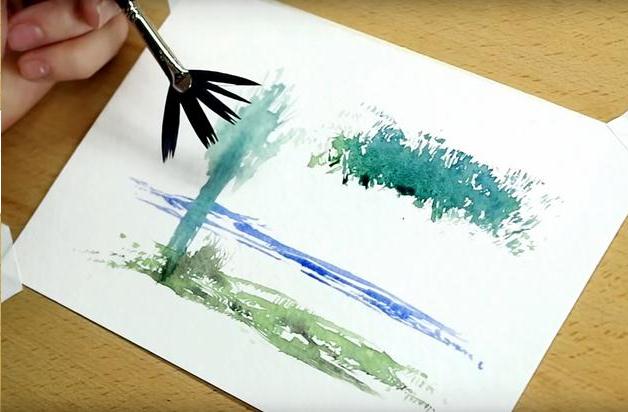Utilizing watercolor as your medium in painting is hard particularly in case you're utilized to obscure mediums, for example, acrylic or oil. Watercolor is extremely straightforward, all things considered. The hues won't appear as effortlessly so you should choose in advance where the zones of white will be in your depiction since you won't have the capacity to paint white over it. Watercolor is additionally difficult to control. You should know and control the measure of water and shade you utilize, else, you won't get your craved impact or the hues will run. Regardless of that, watercolor is genuinely a one of a kind approach to paint pictures since you have a great deal of alternatives with reference to how you'd need the picture to turn out. Through watercolor, you can make excellent pictures with a striking impact.
 |
| Watercolor Brush paint Best Tips |
Here are seven watercolor painting tips to help you begin.
Utilize a dish watercolor
Watercolor paint comes in three distinct structures: fluid, tube, or dish. You may begin honing with any sort however skillet paint sets of watercolor are versatile, minimized, and they accompany a variety of effectively available hues, not at all like fluids or tubes which have isolate holders for every shading. In this manner, it is prescribed to begin with dish paints to make honing less demanding for you.
Draw
Before you begin painting, it's ideal to draw your fancied result first in a little thumbnail. This permits you to rearrange and modify the subject and piece with the goal that you'll know how your picture would turn out. Shade the regions and organize the tonal difference in advance. Thusly, you'll maintain a strategic distance from issues as you paint particularly with regards to painting the light and dim territories in.
Draw a layout
There is nothing amiss with drawing your fancied picture first then simply filling the spaces in the middle of with watercolor. Indeed, it's an awesome approach to acquaint yourself with taking care of the brush and with working with watercolor as medium. Make a blueprint of your picture first then consider it a shading page where you need to finish the picture with watercolor.
 |
| Watercolor brush paint Best Tips |
Pick the correct paper
Similarly as the name proposes, managing watercolor can get extremely wet. You should utilize a paper that would have the capacity to deal with getting wet without tearing effectively due to the wet paint and brush strokes. The level of receptiveness of the paper comes in play, also, particularly in case you're utilizing a wet-in-wet strategy. Hot squeezed paper is less retentive than frosty squeezed paper.
Pick the correct brush
The correct brushes for watercolor painting are those with delicate, long hairs as they can proficiently move watery medium around. The best brushes are produced using normal fiber however they are regularly elusive and costly. While despite everything you're rehearsing, utilize manufactured brushes rather with delicate hairs since they're less costly. Explore different avenues regarding diverse brush sizes and see which works best for you. Commonly, you'll require maybe a couple vast level brushes for laying a wash, and several distinctive measured round brushes for points of interest.
Constrain your palette
In working with watercolor, it's prudent to constrain your hues to around a few, particularly in the early phases of painting. Something else, your work will wind up looking dissonant and sloppy. This is on the grounds that watercolor is exceptionally runny and the hues combine, not lay on top of each other. You can include the more serious hues later on if important.
Watercolor washes
Essentially, there are two ways you can approach a watercolor wash: on wet surface or on dry.
Wet surface wash: To approach a wet surface watercolor wash, begin by dunking your brush in plain water then brush it over the region you'd get a kick out of the chance to paint on. The surface ought to flicker with dampness yet not sopping wet. A while later, dunk your brush into the main shading and paint lines over the wet surface. The paint will mix into one glowing wash of shading.
Dry surface wash: To approach a dry surface watercolor wash, splash a permeable brush, for example, a clean brush with an extremely wet blend of paint. Utilize the brush to paint lines over the dry surface.







